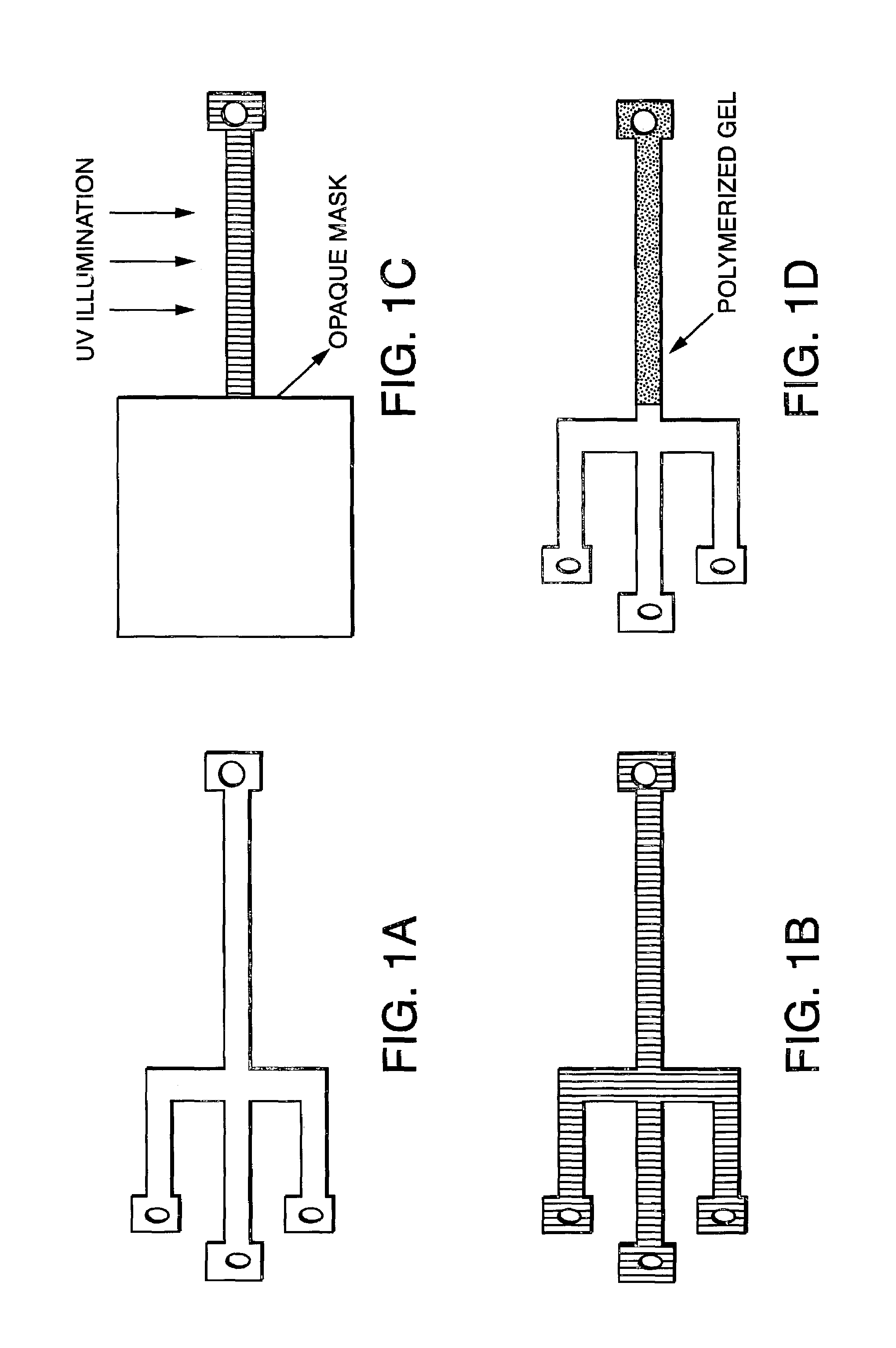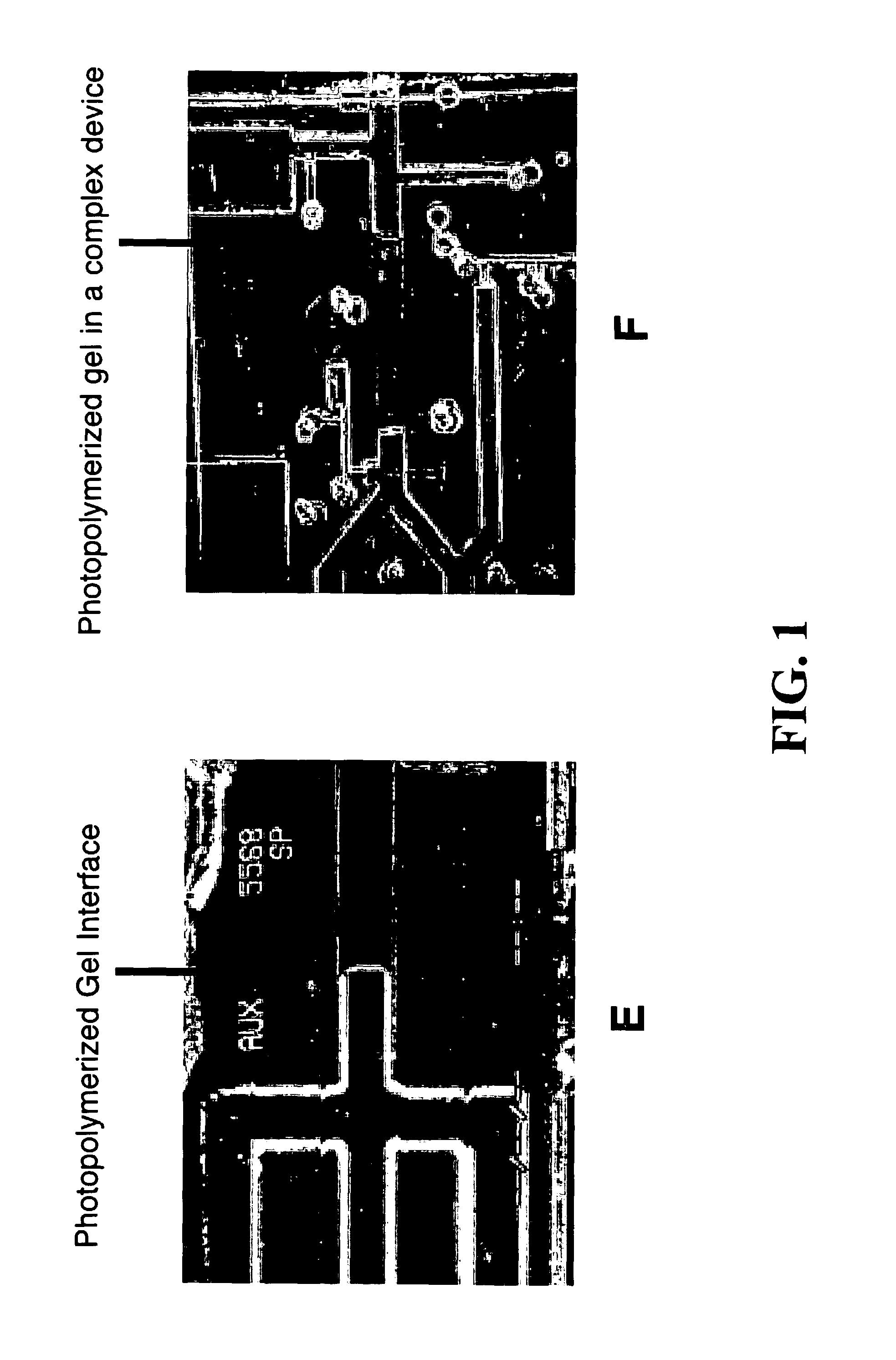Electrophoresis in microfabricated devices using photopolymerized polyacrylamide gels and electrode-defined sample injection
a technology of photopolymerization and polyacrylamide gels, applied in the direction of liquid/fluent solid measurement, fluid pressure measurement, peptides, etc., can solve the problems of unoptimized gel resolution, large size of sample injection, and inability to meet the requirements of modern laboratories, so as to achieve the effect of reducing cost, reducing time, and superior resolution
- Summary
- Abstract
- Description
- Claims
- Application Information
AI Technical Summary
Benefits of technology
Problems solved by technology
Method used
Image
Examples
example 2
Photopolymerized Polyacrylamide Gels
[0093]Having selected the commercially available UV initiated ReproGel™ formulation, the gel casting process was greatly simplified. Two variations of the polymerization mixture were studied: ReproGel™ High Resolution, containing 8% (w / v) acrylamide / bisacrylamide monomers and 1× TBE buffer, and ReproGel™ Long Read, containing 7% (w / v) acrylamide / bisacrylamide monomers and 1.5× TBE buffer. The characteristically small dimensions of microfabricated separation channels demand that care be taken to preserve the integrity of the gel during the casting process by avoiding the introduction of impurities and eliminating bubble formation during the polymerization reaction. However, we found that reproducible high-resolution separations were achievable using the as-received reagents, without the need for additional purification and / or degassing.
[0094]Flat and uniform gel interfaces in the sample loading region could be achieved by partially filling the chan...
example 3
Optimization Of Photopolymerization Time
[0096]Optimization of the polymerization protocol focused on adjusting UV intensity and polymerization time, both of which strongly affect the rate of initiation, with the aim of maximizing separation performance with minimal run-to-run variability. The Reproset™ UV illumination source (Amersham Pharmacia, Kalamazoo, Mich.), designed specifically for use with the ReproGel™ reagents, provided more consistent results than a lower-intensity UV lamp (UVP, San Gabriel, Calif.) and was used as provided in the manufacturers materials. Separation performance was evaluated by observing the migration of a fluorescently labeled 20 base pair molecular ladder (FIGS. 2a–d; samples were directly compacted at the gel interface by application of an electric field (E=10 V / cm) for 20 s. Separation was conducted at E=20 V / cm. Migration direction is left to right. Data shown corresponds to gel polymerization times of (a) 2, (b) 6, (c) 7 and (d) 8 minutes. The doub...
example 4
Microseparations Using Photopolymerized Polyacrylamide
[0099]The first step in electrophoresis after loading the sieving matrix is sample injection. Sample injection in a non-crosslinked sieving media is normally executed electrokinetically using a cross channel with the sample channel perpendicular to the separation channel. For crosslinked media, electrophoretic injection was used. In this technique, a short pulse of a relatively high electric field (10 V / cm for 10 to 20 seconds) was applied between the ends of the separation channel, resulting in compaction of the sample at the gel interface as a consequence of the discontinuity in electrophoretic mobilities inside and outside the gel. After compaction, the field was switched off and the injection ports are flushed with buffer solution. Alternatively, electric fields can be used to achieve an electronic flush to prevent excess sample from entering the separation matrix. Finally, the field was switched back on and increased to the ...
PUM
| Property | Measurement | Unit |
|---|---|---|
| separation length | aaaaa | aaaaa |
| separation length | aaaaa | aaaaa |
| volume | aaaaa | aaaaa |
Abstract
Description
Claims
Application Information
 Login to View More
Login to View More - R&D
- Intellectual Property
- Life Sciences
- Materials
- Tech Scout
- Unparalleled Data Quality
- Higher Quality Content
- 60% Fewer Hallucinations
Browse by: Latest US Patents, China's latest patents, Technical Efficacy Thesaurus, Application Domain, Technology Topic, Popular Technical Reports.
© 2025 PatSnap. All rights reserved.Legal|Privacy policy|Modern Slavery Act Transparency Statement|Sitemap|About US| Contact US: help@patsnap.com



